WWII German Iron Cross Second Class -
The Iron Cross is perhaps the most recognizable award of World War two. It was issued to soldiers in
recognition for bravery. The Iron Cross employed during WWII is very similar to that used during
WWI .
The major differences between the two periods are the dates displayed in the lower arm of the cross
and the absecense of a Swastika in the WWI type.
The Iron Cross was first introduced in 1813 to reward Prussian troops who were engaged in combat with
France and Napoleon. The actual documentation for the award was issued on March 20th 1813. The original
intent was to make the cross a campaign award. It was supposed to replace other state awards such as the
Pour le Merit.
 |
There were several versions of the Iron Cross.
- First Class Iron Cross - This award has a pin back and
does not hang from a ribbon.
- Second Class Iron Cross - The award has a Award has an upper loop where a ring is attached allowing it to be
suspended via a ribbon. This is the award featured on this page.
- Knight's Cross of the Iron Cross - Introduced on September of 1939. Designed to bridge the gap between the
Iron Cross First Class and the Grand Cross.
- Knight's Cross of the Iron Cross with Oak Leaves - Introduced on 3 June 1940.
- Knight's Cross of the Iron Cross with Oak Leaves and swords - Introduced on 15 July 1941.
- Knight's Cross of the Iron Cross with Oak Leaves, swords and diamonds - Introduced on 15 July 1941.
- Knight's Cross of the Iron Cross with Golden Oak Leaves, swords and diamonds - Instituted on January 1945.
awarded to only one person. Hans Ulrich Rudel.
- Star of the Grand Cross of the Iron Cross - This is a prototype award.
- Grand Cross of the Iron Cross - Instituted on September 1st 1939. Identical to the Second Class Iron Cross
except that bigger.
|
IRON CROSS DESIGN
The design of the award consisted of a cross with arms that get wider as they extend from the center.
The top arm has a built-in loop. This is where the ring that holds the ribbin is connected. The body
of the cross is outlined by a ribbed ridge. It is placed about a quarter of an inch away from the
edge of the cross. It follows the contour of the body. The area inside the ridge is painted black.
The outer perimeter is of silver color.
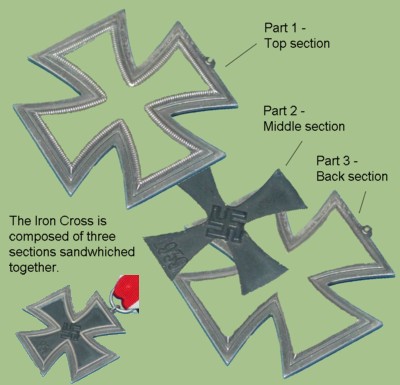 |
The front of the Iron Cross has a raised Swastika in the center. Just below the symbol is the date
1939. The back of the cross displays the date of 1813 in the bottom arm.
The Iron cross is manufactured of Iron.
The Iron Cross is constructed of three pieces. Two identical frames in the shape of the cross with the
center being a third piece consisting of a solid, thin surface. The two frames are pushed together
sandwhiching the center piece.
Because of the construction type, When the cross is turned on its side, a seam should be visible in the
center of the arm. Sometimes it is hard to see but it is present.
|
It is interesting to note that the original design for the Iron Cross was supposed to be a cross platte with a
square box center. The box contaimned the Royal Ciphersurmounted by the Crown of Prussia. Each arm had a sprig
of oak leaves superimposed.
The quarters of the cross were semi-filled and the date of instigation was applied, one number per arm.
The cross was to be suspended from a ribbon consisting of black stripes of Black, white, broad black, white and
black, which are the colors of Prussia.
It was decided not to adopt this design. Instead, the work submited by Karl Friedrich Schinkel was adopted.
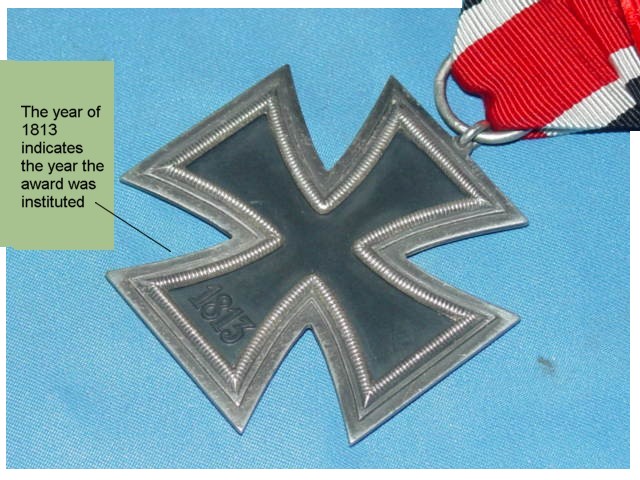
|
This page is a recognition and identification guide for WWII German badges and awards. Multiple
detailed photos of a specific sample are provided. Descriptions point out clearly defined points
that should be noted.
One of the most commonly asked questions is "How much is my WWII German badge worth?". A price
guide is included here to address this question. The value of the badges and awards is reviewed
over a period of several years. A trend can be observed. The present worth of the German
badges in the collector's market is illustrated.
This service is provided free of charge to the visitor/enthusiast courtesy of
MilitaryItems.com,
a company dedicated to the preservation of military history and to providing quality military
antiques and collectibles to museums, institutions and the general public.
|
|
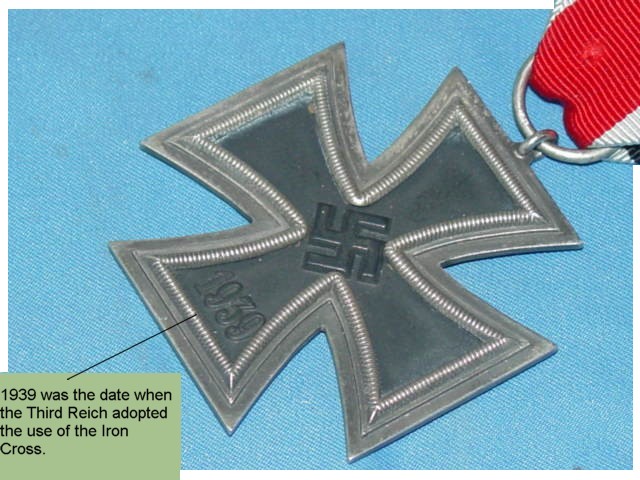
MANUFACTURING MARKINGS
The German military complex during WWII was very concerned about the quality of their equipment. From the weapons right
down to the medals and awards. In the early days of the Third Reich many badges were designed, manufactured and issued
without any standardize form of quality control.
Note that the ring of this example is marked with the number 21. This is the
LDO code
for the company that manufactured the cross.
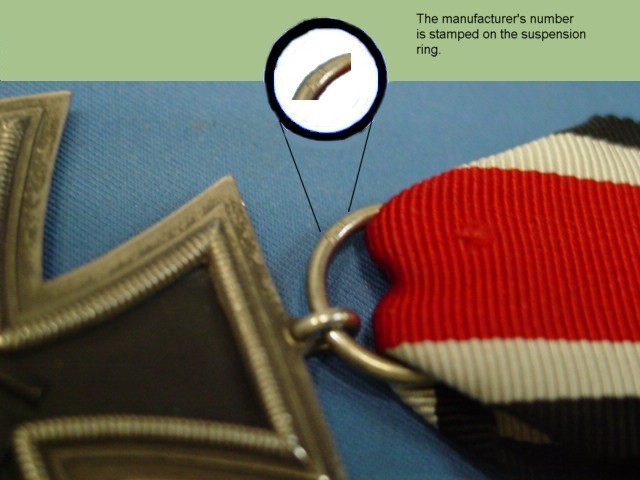
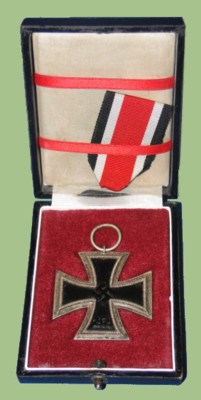
|
HOW THE IRON CROSS WAS PRESENTED
The Iron cross was usually issued in a paper envelope. It could be blue or beige in color. It had a printed
words in the front along with the date of 1939, which is the date when the award was adopted by the Third Reich.
The award was also issued on a box. Although this was not a common occurance. The photo to the right illustrates
what the box looks like.
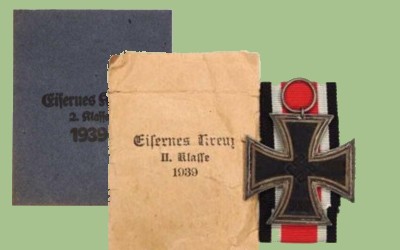
|
IRON CROSS DOCUMENTS
Every Iron Cross was given to the soldier with an award document. This consisted of a khaki piece of paper. In most
instances the drawing of an Iron Cross was found top center. Printed words included "Im Namen des Fuhrers, verleihe
ich dem, das Eiserne Kreuz 2.Klasse", which translates to "In the name of the Fuhrer I bestow the Iron Cross 2 class".
The rest of the information is typed. It contains the name of the person, his title, assignment and the date in
which the award is issued.
The document is signed by the person who awarded it. An official stamp is applied to one corner. This is a very
simple document that does not have much fanfare.
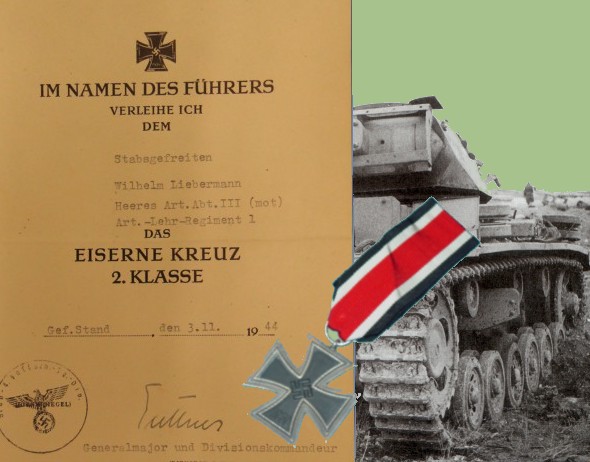
The document is signed by the person who awarded it. An official stamp is applied to one corner. This is a very
simple document that does not have much fanfare.
BY THE NUMBERS
It is hard to determine the exact number of Iron Crosses that were produced. However, thanks to the record keeping
maintained by the Wehrmacht, it is possible to find how many crosses were actually issued.
The actual number of Iron Crosses produced is greater than the number that was issue. It must be accounted that the
armed forces would have a stock in hand so it could replace lost ones and issue new awards. In addition the factories
were likely to have warehouses with inventory at hand. The Iron Cross was one of the awards most widely distributed
during WWII.
The population of Germany in 1939 was approximately 64,000,000.
COLLECTING IRON CROSSES
Collecting Third Reich memorabilia is a field that has been growing since the days the GI's rummaged around Europe
bringing back military souvenirs. German soldiers wore many of their awards on their uniforms when they went to battle.
Once the soldier was killed or captured, the American soldiers would take the awards as war trophies. Eventually all
these pieces came back to the United States where military history enthusiasts began to collect them.
|
"I am trying to figure out if I should get into collecting Infantry Assault badges."
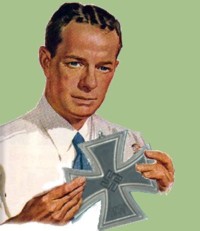 |
Determining which military badges to collect can be a challenging decision. The combination of availabiilty and
cost will often set the pace of what can be collected.
The adjacent table outlines some of the advantages and disadvantages of collecting the Infantry Assault badge.
|
|
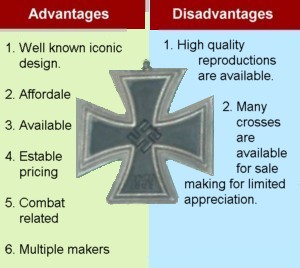
|
| 






